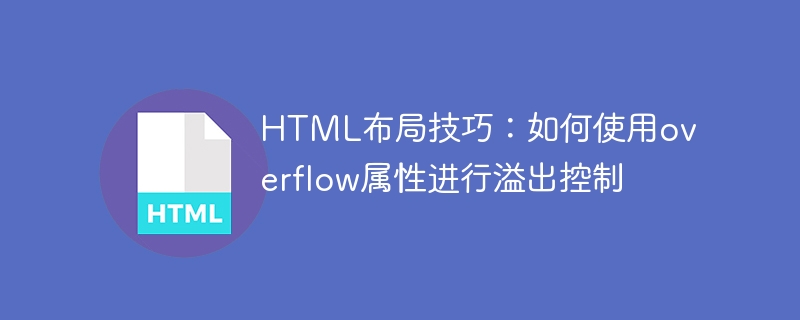

HTML layout skills: How to use the overflow attribute for overflow control
When laying out a web page, sometimes you will encounter the problem of too much content that cannot be fully displayed. At this time, we can use the overflow attribute to control how the overflowed content is displayed. By rationally using the overflow attribute, you can make the web page layout more beautiful and provide a good user experience.
The overflow attribute can be applied to any element with a fixed height or width. It has the following values:
The following are some specific code examples to help readers better understand how to use the overflow attribute for overflow control.
<style>
.container {
width: 200px;
height: 100px;
overflow: hidden;
}
</style>
<div class="container">
Lorem ipsum dolor sit amet, consectetur adipiscing elit.
</div>In the example above, the container has a width of 200px and a height of 100px. The content exceeds the height of the container, but because overflow: hidden is set, the excess content will be hidden.
<style>
.container {
width: 200px;
height: 100px;
overflow: scroll;
}
</style>
<div class="container">
Lorem ipsum dolor sit amet, consectetur adipiscing elit.
</div>In this example, the container has a width of 200px and a height of 100px. The content exceeds the height of the container. Because overflow: scroll is set, a vertical scroll bar will appear, and the user can view the complete content through the scroll bar.
<style>
.container {
width: 200px;
height: 100px;
overflow: auto;
}
</style>
<div class="container">
Lorem ipsum dolor sit amet, consectetur adipiscing elit.
</div>In this example, the width of the container is 200px and the height is 100px. The content does not exceed the height of the container, so no scrollbars appear. However, if the content exceeds the height of the container, a vertical scroll bar will automatically appear for the user to browse.
In actual web design, according to different needs, reasonable use of the overflow attribute can increase the readability and interactivity of the page. For example, in a navigation menu, when the menu has too much content, you can set overflow: scroll to display a vertical scroll bar so that users can easily view all menu items.
To summarize, the overflow attribute is a very practical CSS attribute that can help us solve the problem of content overflow in web page layout. We can choose appropriate values to control the display of overflow content based on specific needs. In practical applications, we can combine other CSS properties and JavaScript to further optimize the user experience of the web page.
The above is the detailed content of HTML layout tips: How to use the overflow attribute for overflow control. For more information, please follow other related articles on the PHP Chinese website!
 How to be invisible online on TikTok
How to be invisible online on TikTok
 How to shut down after running the nohup command
How to shut down after running the nohup command
 How to remove the border of the text box
How to remove the border of the text box
 How to define strings in php
How to define strings in php
 How to enter the 404 website
How to enter the 404 website
 What is star network topology?
What is star network topology?
 The difference between concat and push in JS
The difference between concat and push in JS
 How to learn python programming from scratch
How to learn python programming from scratch




